Story Pile: The Dragon Prince
The Dragon Prince is a netflix television show about an elf, a prince, a dragon, and all the complex challenges they have thanks to some mishandled jam tarts. If you just wonder about my general perspective, or if I’d recommend it, this show is great, bursting with personality, with good comic timing for its comic relief, wonderful action sequences, excellent voice acting (it really grew on me), and a number of characters who don’t overcorrect away from their archetypes while not sliding into being banal or overfamiliar. It’s great. Check it out. Easily worth paying for a month of Netflix and binging it all over a few weeks.
Now, if you want more, that’s after the fold. What is going to follow is pretty spoiler-free, but I want you I will say mean things about the Voltron fandom and criticise the ending of Avatar: The Last Airbender.
September 2019 Wrapup!
I knew, ahead of time, this month would not be full of bangers. It’s been a busy month, with time spent on marking student work and time spent on a major component of my PhD. That means that the month of September was just not a time for writing to be done, certainly not writing I wanted to do. I still met my goals and made sure that every day something got added to the queue, but in a month of intense, terrifying writing when dealing with confrontational unreceptive audiences, I still put out some articles I liked: My three pieces on Pokemon Go and my fondness for Gen 5 Pokemon, for example, my rip on Titans for being bad (it is bad, boom gottem), and the Pop Stars article that was necessary to set up making fun of an album cover.
Technically, this is a two-video month. I put up a video of me showing off a Minecraft base I made, but only one person saw that, so it’s a bit of an unrelated non-factor. The other video this month is a bit of a voice-overy one that wants to connect Speed Running, Algorithms, Big Data and Neoliberalism, so what better to do than talk over Mirror’s Edge?
This month is also my first time dealing with my new upload speeds from my new ISP, which has meant that suddenly I get a few extra days of time to work with video. This time around, thanks to these improved speeds, I was able to download another person’s video (and used it with permission, don’t worry), to make making this video a shitload easier. Rather than needing to capture the video myself, I can use games I’ve already played and didn’t record (like Mirror’s Edge, which I at first played almost ten years ago) and instead focus on the writing, knowing that there’s video on hand that can be available if I ask for it.
So hey, my infrastructure has improved and my videomaking has been able to improve with it.
I’ve also taken on some advice from Chris Franklin, aka Campster, who noted that an hour or two of video essay is pretty wasteful and self-indulgent, and I realised that I don’t need to make a video an hour long to convey some very important, interesting points. That gives us ten minutes to run over the idea of Platform Capitalism and Speedrunning, as told by Mirror’s Edge.
Anyway, this month’s shirt is this Byleth inspired pair of designs:

I’m not a Fire Emblem person, but I did watch as for a chunk of August and September just kinda seeing my friend network dissolve under the presence of a Fire Emblem game releasing. I made these shirts for no greater reason than I think the iconography on the chest of Byleth is kinda interesting, but after extracting them I gotta say it’s kind of a rip how boring the dude set is.
Game work, not much has happened, but it’s been a big month (see below), but it is now the time when I start working on some games for University. Which is going to be interesting because I don’t honestly know how this projects outwards going on. I have a plan but is it going to work? Who knows.
In my personal life, this has been a very demanding month in terms of my University time (where I have had to meet the needs of my PhD) and my family time. The backlog of articles this month got as low as twelve at one point, but it did get brought back up, and we should be good to go into October, a month with a theme.
I Like: Mumbo Jumbo and Grian
Hey, I have niblings! And they love Minecraft! And the most well known Minecraft celebrity in the world keeps having to make excuses for why he keeps doing nazi things! Which is not behaviour you really want to see in content that is aimed at literal actual children and good god what a piece of human garbage.
Nonetheless, I have gone looking for Minecraft youtubers who make approachable, kid friendly content that isn’t full of occasional horrifying racism and othersuch garbage, and I’ve found a pair of exciteable British boys who, at least in the content I’ve found, aren’t likely to teach my niblings slurs.
First, there’s Mumbo:
And next there’s Grian:
Grian and Mumbo are two Youtubers with different channels; Grian is fussy about the aesthetics of buildings and architecture, and Mumbo is a redstone nerd. They make short videos on a regular basis, they work together from time to time, and they do a lot of Minecraft content that looks at the game as an aesthetic pursuit (making things that look good), and a technical one (making things that serve a purpose).
Now, that’s not to say these two are perfect, for all I know in the thousands of hours of content they’re making there’s some awful stuff and I’m going to learn about it and be sad about it, but at least at the moment they appear to know they’re basically making Art Attack with Pixels.
Game Pile: Mirror’s Edge (and Platform Capitalism)
September Shirt: Byleth Ribbons
Well, a new Fire Emblem happened! I’m not into it, but all my friends are, and I like my friends. Also, I love looking at iconography in games, things that evoke things without actually being things.
I was originally conceiving of a set of silhouettes of characters with text evoking who they were or what mattered to them, which would be fun, but my attempt to gather suggestions for that resulted in pretty much nothing but jokes, because, well, aren’t you a sweet and helpful audience of friends?

Anyway, so I did some Byleth shirt designs. Here they are:
ˢᵉˡˡᶦⁿᵍ ᵗᶦⁿʸ ᵇᵒᵒᵏˢ
One of the weirdest things about the kind of things I make is that at a convention it’s very hard (read: impossible) to get people to engage with the bulk of what I do. I write! I write a lot! But people don’t buy words unless they’re stuck to a bit of a tree, hammered flat, a system that seems dreadfully inefficient.
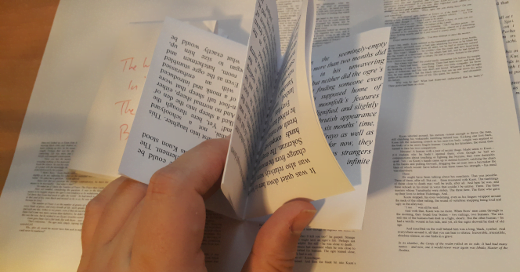
I’ve been experimenting then with ways that I can make small, printable, books, something I can pump a few out before a con and sell or give away as promotional devices for my games, or maybe some microfiction (do I do that?). This first idea is one that I saw first on Twitter as a kind of suggestion for making tiny comic zines, and that idea is pretty cool.
I don’t make comics, though, I make game rules and words and I found this design really neat. However, it’s sometimes hard to find – I search for ‘gay robot kiss’ and dig through my retweets, for example – so I made a template and a place to show it where it can be easily accessed.
Another thing to bear in mind is you wind up with 6 faces the size of a card, more or less, and that means you want a font size around 9~ish. It depends on the individual font, of course, and how much text you’re putting in. So far I haven’t experimented much beyond finding limits – the amount of text I can jam in, which hovers around 550 words or so. That’s pretty sensible – it’s about what you can fit on a single page, too.
Some things I’m considering putting in this format
- catalogue of card games I’ve made
- popular blog posts
- a single short prestige class or paragon path
- a spellbook for a D&D character
- a micro RPG
- an RPG seed or scenario
- a character background guide
We’ll see what comes of these ideas!
After the fold is just my template for this, to make it easy to find by searching for ‘small booklet’ or ‘personal zine’ or ‘a4 booklet.’
MTG: Dancing In The Cinders
Is it something about Aristocrats decks that get me to come out and play? Is that what pulls me into Standard? I feel dirty, like somehow it’s just the interaction between some junk drawer creature and a junk lord and suddenly I’m just an easy get for a standard environment.
Anyway, I’ve been playing Magic: The Gathering a little more, and rather than hanging around in the silly waters of Commander 1v1 (a format where I mostly goldfish), I’ve been playing Standard and Modern (and we’ll get to that), based on throwing together a reasonably cheap deck. Right now is one of the best times to get a standard deck with a good mana base together, because there’s a standard-legal Ravnica set, pulling the cost on Ravnica duals down to nearly a buck each on MTGO.
[d title=”Mardu Aristocrats, September 2019″ style=”embedded”]Creatures
4 Hunted Witness
4 Grim Initiate
4 Tithe Taker
4 Priest of Forgotten Gods
4 Cruel Celebrant
4 Mayhem Devil
2 Imperious Oligarch
2 Judith, The Scourge Diva
2 Midnight Reaper
1 Ministrant of Obligation
1 Demon of Catastrophes
Spells
4 Spark Harvest
Lands
4 Blood Crypt
4 Dragonskull Summit
4 Godless Shrine
4 Isolated Chapel
4 Sacred Foundry
4 Clifftop Retreat
[/d]
The basic anatomy of this kind of deck, known colloquially as an Aristocrats deck is threefold; you want cards that don’t mind being sacrificed (‘food’), you want things that can sacrifice cards for benefit (‘feeders’), and things that react to the interactions between the first two (‘zookeepers’). It’s a neat little ecosystem of a deck and part of what I like about it is how it makes a lot of creatures that are, at best, kinda cheap and durdly, into something your opponent has to spend their cards on, and even then, they’re not guaranteed to get ahead when that happens.
This deck is by no means what you’d call ‘good’ – the last time I did this I had [mtg_card]Zulaport Cutthroat[/mtg_card], and let me tell you, [mtg_card]Cruel Celebrant[/mtg_card] is no Cutthroat. Or maybe I’m just sour about mana in general. There’s also the way that [mtg_card]Mayhem Devil[/mtg_card] works, dealing damage wherever you like but also crucially making that damage require sacrifice. There are draws however where you get some mix like a [mtg_card]Hunted Witness[/mtg_card] into a [mtg_card]Priest of Forgotten Gods[/mtg_card] into [mtg_card]Cruel Celebrant[/mtg_card] and [mtg_card]Grim Initiate[/mtg_card], and you blow your opponent’s board up, draw some cards and then drop another Priest of the Forgotten Gods, and then they cheer and people pick you up and lead you around the room and you’re just the best.
And those games are pretty fun, especially in the low-stakes casual standard room where you are going to face things like Treefolk Tribal and Ladies Facing Left. Still, there are plenty of times you draw a hand and you’re looking at a fistful of 1/1s and a land, or 4 mayhem devils and three lands and know you’re probably not winning with that. It doesn’t mulligan great either – you kind of need a mix of your pieces, and every card you start down loses you a piece, and a chance at a better piece.
Nonetheless, I really enjoy this deck and it’s pretty rotation proof at the moment. I don’t know what’s going to add to it in the upcoming sets, but for now, it’s a fun little unit. I need to develop it a sideboard, though, so I can play it casually in the Tournament room, rather than hang in the much more variable space of the casual room.
Story Pile: Highcumberland Jubilee
I love Jimmy Buffett.
I know, I’m not cool.
I’ve mentioned that I grew up in a media bubble. This space was one where I couldn’t really buy new albums, and my exposure to pop music was little snippets of music from – I kid you not – television ads for compilation albums of ‘the hottest songs of the’ etcetera. When I started engaging with pop music, it wasn’t the pop music aimed at me, it was the pop music that’d been aimed at my dad, because in our secret cupboard, we had hidden away, vinyl records of satanic, dangerous, wild music, like The Eagles and The Moody Blues.
Dad also owned every Jimmy Buffett album, in some form or another, from High Cumberland Jubilee through to Coconut Telegraph, mostly on old vinyl, and once, he tasked me to record all his vinyl onto tape so he could listen to it in the car. I took to this task, and while I was at it, I made recordings for myself, to listen to in my room. They anchored to my soul, singable music that I listened to over and over again, and became my bedrock for learning such ridiculous ideas as fictional narrative in music.
I’ll restate that: Jimmy Buffett is the place I realised that stories in songs can be fake.
Is Elmo Black?
I brought this up a little while ago and I thought at the time it’d be a simple enough question. I wanted to make sure before I went in on it, though, that I knew whether or not I was dealing with something obvious to people who weren’t as far as I am as outside of American Blackness.
It reads a bit like a trick question, I think. Elmo after all, is not a black person, he is a muppet. Not only is he not human, he’s not an African-American, and if nothing else, he’s red.
Why then, would I ask if Elmo is black?

First, Elmo is a character who is performed. Elmo is not someone you inherently perform when you get the Elmo puppet; look at all the many lovable scamps making hilarious jokes about Muppets saying dirty words when they get their hands on an elmo toy. There’s a style guide to Elmo; he has a vocabulary and a characterisation, and those things are built on what the character’s already done, the image he projects to the audience. Those details are made up of a history of Elmo performances, which are themselves informed by the people who have creative control over what Elmo ‘should’ have and do, starting with Elmo’s creator, the first person to make an Elmo, and define the character as he should work.
That creator, Kevin Clash (who is it seems probably a bad dude, alas, but this is not the venue for that conversation), is a black man. He defined Elmo’s voice, and vocabulary, and mannerism, and also puppeteered him for decades, too – which means that Elmo’s manner and behaviour was all being defined by someone who lived and experienced blackness. Even though right now, Ryan Dillon is Elmo’s primary puppeteer, and Ryan Dillon isn’t a black man, the upshot is that Ryan Dillon, performing Elmo is going to perform some of what Kevin Clash performed.
In this way, the question becomes: Does Elmo inherit blackness from Kevin Clash? Does he do or relate to the world the way that a black kid might, especially in the context of a life that isn’t tainted by the way our world oppresses black kids? To what extent does the blackness Kevin Clash put into Elmo’s performance still persist as Ryan Dillon attempts to continue playing that character faithfully?
Elmo is a performance; Elmo is a character defined and created by a black man; does that black man’s performance bring with it blackness?
This is why I asked the question.
I don’t have an answer, by the way. The answer as best can be understood is if black people, other people who know how it is and what it means, to perform blackness, can look at Elmo and intuitively grasp that he’s ‘meant’ to be black, or that he’s a participant in their experience.
Popstars Was Weird
Australia has a really unpleasantly comfortable relationship with reality TV.
I understand that just because I dislike reality TV doesn’t mean it’s an inherently unworthy media form, but I think that Reality TV’s relationship to Australian culture can be seen as a symptom, because its a kind of illness. There’s a lot of shows we could be making that we’re definitely, definitely not making, because it’s cheaper to make reality TV shows, and that means our entire TV model is biased towards making these cheap shows and trying hard as possible to drive engagement with them, and seemingly because of our national character perhaps, we drive these engagements with the most awful, antisocial kind of stuff. The reality TV show is something that we’ve been doing for my whole life, more or less, in the controlled space of the lifestyle and vet program, leading around the prolonged misery dare of The Block and House From Hell, or the pseudovoyeuristic ‘game show’ of observing assholes with Big Brother or the ‘documentary’ of rich people problems like Sylvania Waters, and, of course, the utterly empty promises of reality TV in the form of the talent show.
There’s an industry pumping these things out; for a brief time there I thought it was worth my time to keep some framing in my mind to tell which ones came from England and America and Canada and also the ones from Australia, because these shows were made by a business that then outsources them, then the resultant products are merchandised across all the countries that speak the language and for some reason we here in Australia have a remarkably deep desire for these shows.
And I remember a first one.
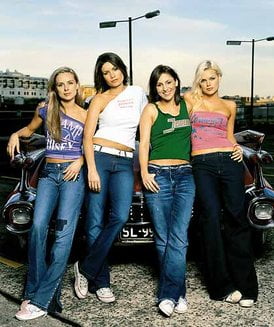
It wasn’t necessarily the first. I don’t know. I don’t care. We’re getting to a very specific place, just bear with me. See, Australia had this reality TV show back in the 90s, called Popstars. An idea that started in New Zealand, proving that not everything they did is better than we do, Popstars is your basic formula talent show. Information about it in hindsight is scarce: I seem to remember that it was about building a pop group out of a variety of participants, rather than any one person winning.
Popstars was participated in by a bunch of people nobody remembers, and it was staffed by a bunch of other people nobody remembers. I literally only have had this show held in my memory by TISM making fun of it, referring to a choreographer as ‘that bloke from Popstars that looks likes the Paddlepop Lion and who you could tell was so enjoying his chance to bully a bunch of twenty year olds,’ and if that song, BFW, didn’t have its own timelessness to it, I would have absolutely forgotten Popstars.
Well, except for one thing.
Popstars had a ‘winner,’ of a sort, there was something that came out the other end of its extrusion, a bubblegum pop girl band called Bardot. Bardot had one album, also called Bardot. They are eminently forgettable; I cannot tell you how their song sounded, nor how well their album did. I thought at first they were a complete stone dropped off a cliff, a complete nothing of a band, but no, it turns out they had a ‘successful’ album and a ‘successful’ follow-up album. They dissolved in 2002, to pursue solo careers, which based on subsequent releases, they immediately caught, then went home. Popstars continued for a few more years, tried to make a few more bands (like ‘Scandal’us‘), and was eventually outmoded and displaced by Idol, which it directly inspired.
Now, there are two reasons to remember Bardot.
The first reason to know about Bardot is that Bardot had two number one hits in Australia, that not even Australians of age at the time remember, was nominated for ARIA awards, and lost to Savage Garden (because we live in a society). Despite this, you can’t get them on Spotify. You can’t find them on any online streaming service, at all. You can’t buy them on iTunes. And this is because the licenser responsible for owning all their music has declared that it wouldn’t make enough money to make it worth doing.
They own the music.
They don’t need to pay anyone royalties.
They are saying that it wouldn’t make them enough money to do the paperwork required to stream these songs.
That’s kinda devastating.
Anyway, here’s the other thing about Bardot that’s worth remembering. You might imagine so far that this being a bubblegum pop band created in a public television program to manufacture a band there’d be some criticism of the band as being ‘fake’ in some way. Artificial. Also, the selection of performers was a range of Photogenically Attractive Skinny White Girls, which furthers the comparison to mannequins or dolls.
The people making the album took this criticism on board, then and what we got was this album cover.
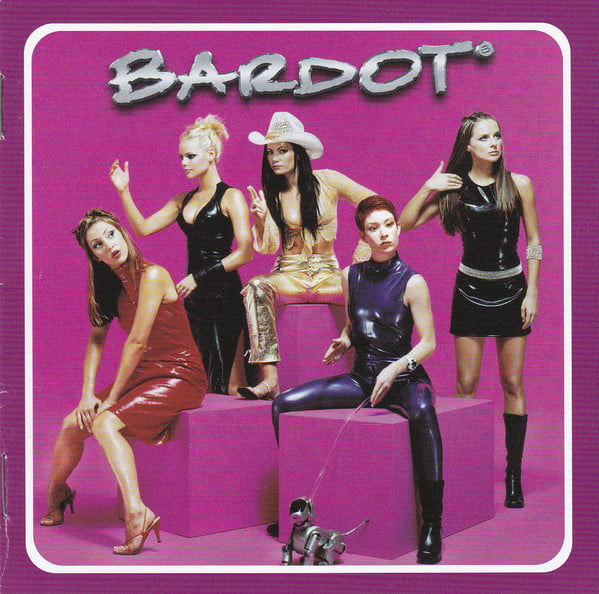
It’s clear the aim is to riff on the criticism – ha ha, let’s present them as mannequins, as plastic dolls in plastic clothes, suggesting we can tell that people think of this as a ‘fake’ band! That’s you know, so far so what, and hey, look, they’re people who make media involving women that treats them as objects, this isn’t news or meaningful. That’s not really the thing about this cover that’s bugged me. Though I guess at the same time, boy, I bet there are a lot of people who had their bimbofication or dollification kinks awakened here.
No, what’s haunted me about this album cover for decades is that this is a professionally made album cover, made by people who were ostensibly professionals, and they didn’t think to look at the transparent plastic ‘lead’ they gave the model in the front right to hold to connect her to her ‘dog’ that is, yes, ha ha, artificial. Because the way it’s positioned, the way it’s plastic, the way her hand isn’t tangibly holding anything – it absolutely looks like she’s peeing on it.
Game Pile: Pokemon Go
Pokemon is a rich vein of hashtag content for hashtag content hashtag creators, who are trying to hashtag drive hashtag engagement. For that reason I’ve largely left the subject alone except when the tumult has grown so tempestuous I find myself driven to shout about it. I think most of my reviews of Pokemon main games would be a little tedious – I’ve talked about the difficulty of talking about them in the past, where these games are largely just really good, and critically engaging with them in any way is a matter of picking over a game that’s 99% positive finding the 1% that’s got something interesting enough to talk about.
Not so Pokemon Go, though, which is probably the most successful and widespread alternate reality game that exists in the world right now, at least as far as I, someone who speaks only English, am aware. Remember, there are more mobile phones in China than there are people in America – if it turns out there’s some amazing thing happening on the other side of the Great Firewall, I wouldn’t know about it. Anyway, point is, Pokemon Go is a big deal, and it’s not a sequel in a meaningful way and it’s not a refinement of a nearly perfected formula.
Gen 5, Part Two, PoGo
Oh hey, you thought I was done? The subject said Part One, c’mon, let’s not waste any more time.
Continue Reading →
Gen 5, Part One, PoGo
I’ve mentioned in the past, or maybe in the future, I don’t know how the scheduling works out, that the presence of Garchomp in Pokemon Go was my personal ‘there goes the neighbourhood’ metric. I’m a bitter, bitter boy and Garchomp was one of the things that drove me away from online Pokemon battling back in Generation 4. Comical then is that that drive also led to me missing out on a generation I think I would have loved until I was sick of it, Generation 5, of the infamous Weather Wars.
I’m just going to assume, if you’re going to keep reading that you either know enough about Pokemon that explaining Weather Wars would be old news to you, or so new that you don’t care to learn the four or five different interconnected systems to learn why weather was so goddamn important. We’re just going to skip over and if you want me to explain it in my plain-languagey explainy way, you can ask me to explain the Weather Wars later.
Anyway.
Still, Generation 5 was great, because it was Pokemon game, and they’re all great, because that’s the way Pokemon games work, something to do with them all being really great. A thing I loved about Gen 5 though was that this was a time when the Pokedex – the collection of Pokemon you’d encounter – was pretty much completely new, so you saw almost nothing but new Pokemon, and you wouldn’t see your old favourites until after you got to the end of the game. Bit of a bummer if you carried the same Pikachu from two generations back, but if you were the kind of person who was seeking new experiences, like me, Gen 5 was so full of brand new friends to make it was great.
And since the internet loves lists, here’s a list of Some Pokemons from Generation V, and why I like them, to give my Pokemon Goer friends some context!
Not Our Crisper
I’ve been thinking about the crisper in our fridge.
You know, the fridge with a broken light, where, no matter what, for some reason, I keep going and expecting to have the light turn on in the middle of the night. It’s a decent fridge, and I’ve never really had a problem with anything about the fridge does. It’s never occurred to me to fix the light but it’s also never occurred to me to consider whether or not the fridge is, you know, good for my purposes.

The fridge is atmospheric to me. It is passive. It is background storytelling, it is a wall texture in my own personal level 0, my own travel hub. I don’t even think about changing the fridge, or doing things to make the fridge better. I fill it, I empty it, I clean it, it’s a fridge, right?
Well tonight is the first night I realised that for six months, or more, I’ve been loading vegetables in the crisper drawer, and playing tetris with it. That I’ve been fussing and turning and trying to make capsicums fit in this side and the carrots can lay flat on the bottom or they can prop up on the side. Then there’s the two lettuces, and the cabbage, that just sits up there, up on top.
I don’t talk about eating as much as I talk about food prep. It may just be this is one week, where it’s really obvious to me, where hey, I need to fit a lot of vegetables here. But it was enough to make me notice a thing that’s normally functionally invisible to me: My crisper draw is too small. Not so much that I’ll change the fridge. Just… a little bit of a weird thing to notice.
I at no point noticed that in my plans for cooking and preparing food, the thing I’ve been doing is consuming enough vegetables that my storage for them hasn’t been suited to task. It’s strange, it’s a kind of progress. Yet at the same time it was a kind of magic trick played on me, or rather, that moment of noticing this change in my life was itself, that same sensation. Startled.
A magic trick is essentially, constant and perfect control over perception. Controlling your own perception, recognising its boundaries, and sometimes you can change it without even noticing it.
Story Pile: Haibane Renmei, Kinda
This is about Haibane Renmei. It’s also not really about Haibane Renmei, not really.
Let me explain.
Haibane Renmei is a generally highly-regarded, extremely pretty and artistically significant entry in that genre of media about sad looking girls suffering as a metaphor for some big ideas. It’s safe to say it’s not my cup of tea and I say that as someone who doesn’t even drink tea. Nonetheless, it is beautiful and atmospheric and thoughtful and poignant and everyone I know has a crush on someone in this story, even the people who aren’t massive lesbians.
MGP: Time To Grow
Starting January 2016, I made a game or more a month for the whole year. I continued this until 2018, creating a corpus of 39 card or board games, including Looking For Group, Senpai Notice Me, and Dog Bear. Starting in 2019, I wanted to write about this experience, and advice I gained from doing it for you. Articles about the MGP are about that experience, the Monthly Game Project.
I’ve talked about the Monthly Game Project, but there’s a point I really need to hammer in that I didn’t get to appreciate when I was doing it.
Things take time.
I am not going to lie, I get jealous when I see fandoms. I get jealous when I see fandoms for incomplete ongoing works. I get jealous when I watch as the games and things I make have sunk beneath the waves. The idea goes that if you make something and put it out there, with sincerity and positivity, you will get attention and people will connect to it and it’ll be great. You can look to the example of certain darling games, or darling devs, people with support and fanbases and people who are eager and enthusiastic to see the result of their work, even after months or years.
This is reasonable, I feel, as jealousy, and anyone who wants to tell me my feelings are illegitimate or unreasonable can eat a dick. But as with all of these feelings, I want to use that sensation and consider what I can do around it. What I’m doing to make it harder to have that fandom. I do think I have a fandom (and it’s very small, and I love you so much). And I think part of the problem is that I have people who genuinely have no idea that some of my games even came out.
I didn’t have a handle on releasing a game each month. I wasn’t having to rely on user bases, I wasn’t doing something like Button Shy do – I made a game a month on public print on demand, and that game production didn’t have a consistant approach for building hype, consistent outlets or rollouts, or planned times for release. I didn’t do hype – I just dropped a game out of nowhere.
Also, I tended to route around the things that make for good ‘pops’ – I sent some of my games to reviewers, and literally none of them ever came through. My response to that was to stop trying to get reviewers to look at my games; I simply gave up. That sucks for me, because I know for a fact that a bulk of the early sales of Dog Bear, and the reasons why it’s one of my most successful games, is because there was one Redditor who kept mentioning it for about a year. Not a proactive thing – it was just one game they mentioned in a discussion of RPGs.
There’s this idea we have in digital marketing, of the idea of the long tail. Notionally, it’s the idea of building up a big library of things that don’t have wide appeal – a few sales from a larger, browsed library will slowly, over time get attention and that’ll get people interested. It’s a model that works, go wide instead of focusing on a few hits. But my library of games is honestly so big that as one person, it’s kinda just… intimidating to look through, and even at a convention it’s hard to convince people to check them out. I do public threads, exploring and explaining games as I make them, and those can be cool, but I feel like they need to be timed to be events.
Fact is, not everyone is checking twitter actively.
I made Fabricators in a weekend. I don’t regret that – I love that game, it’s sweet and tight and it uses a good engine I observed other games using, and I was able to make a game that’s very much its own distinctive kind of thing, a hard euro game that builds itself around a cooperative tenor. And that’s great, but the entire window of time when you saw me working on that game, then talking about the game, then releasing the game was four days.
The hype cycle for games, even small games, is long. It is long and slow and players can only buy games so quickly. Even if the game is made, I feel like the best course of action, the plan I have going forwards, is to sit on the game, to share it with a few people, on patreon, and the like, and spend the remaining time and effort on polishing and refining the game. Build some hype, maybe. Find the people who respond to it well, and maybe get back to trying to get people to review it.
Time to make things is one thing, but time to make interest is another.
Implying Barbie
No, this isn’t about bimbofication.
Sorry.
Wait, who’s waiting for that take from me? Never mind.
Point is, Barbie.
I am somewhat sympathetic to people who are unhappy with Barbie. After all, Barbie is absolutely a juggernaut in the media landscape of our lives. Barbie is so vast that she can – and of course I mean the media brand and company and so on and so off, whatever – basically choose how a significant volume of the things in media around us get represented. And that means criticising Barbie’s representation of, say, women, is a really valid and good pursuit because the brand is in a position to not just represent reality, but to set rules for how other people represent it. It’s an enormous power, and the way that Barbie, for example, presented girls as almost always white for a long time is definitely a problem.

Still, there’s something about barbie and other dolls that feels like it’s sometimes missed, which is that these dolls are made to be played with, and playing with a doll – the ‘play pattern,’ as the industry says – involves dressing the doll in clothes.
There’s a bunch of stuff about Barbie that doesn’t make sense if Barbie is meant to be a representative of a real human body; her preposterous proportions, her torpedo-shaped boobs (and I again, promise, this isn’t about bimbofication), her giraffeish neck and her bobbly top-heavy head, those things are all elements of the doll’s design that exist to make sure that Barbie’s default state is presenting a literal, actual clothes horse.
Now, Barbie is by nature, implying that she is a prop for her clothes, and you can get into the semiotics of that, but at its core, a lot of what Barbie is trying to do is ‘look right’ when scaled down to a tiny shape that also has distinctive, visually observable hips and shoulders and boobs. I’m not saying she’s not built to a particular standard (and that standard is the one our fatphobic society, in which we live, definitely wants to validate).
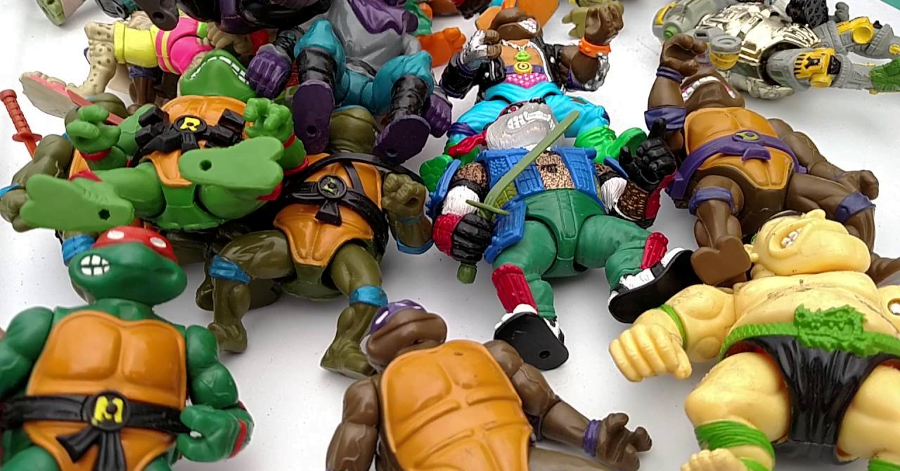
At the same time, though when you look at boy’s toys, there’s a similar implication of the toy’s purpose. The natural way a Teenage Mutant Ninja Turtles toy sits is a pose that brandishes weapons, arms and legs tense and ready for action. The play pattern of these toys is what tends to get referred to by Hasbro as ‘battle play,’ where the figures get hit against one another, to represent a narrative, to describe a combat where there are winners and losers.
That’s why the dolls – which are dolls, let’s not kid ourselves – the dolls for boys are made to have things like being easily gripped and handled; it’s why they have neutrally combative stances; it’s why their proportions and design are built towards making them tough and durable, more than making them posable.
This isn’t meant to be something revolutionary! This is not only a known thing about Barbie’s design, it’s been known for years, since basically she was first made. And it puts us in this weird place where people, sensitive to the real problems Barbie has been part of have to try and grapple with all the problems of Barbie even the ones that are about what Barbie is trying to do (as a doll) and the things Barbie is trying to imply by how she is.
Game Pile: WitchWay
There’s a model for how the Game Pile works. When it started, it was almost a sort of penitence diary, a way for me to talk about the games in my Steam Library as I committed to play through them, with the idea that it would be a long process where I could eventually ‘finish’ my Steam Library. It was almost done as a sort of deliberate demonstration of engagement – hey, people who bought me these gifts, here I am, playing them, please have your money and time and belief in me respected.
Work In Progress: Combo Shirts
Okay, first things first, here’s a design.
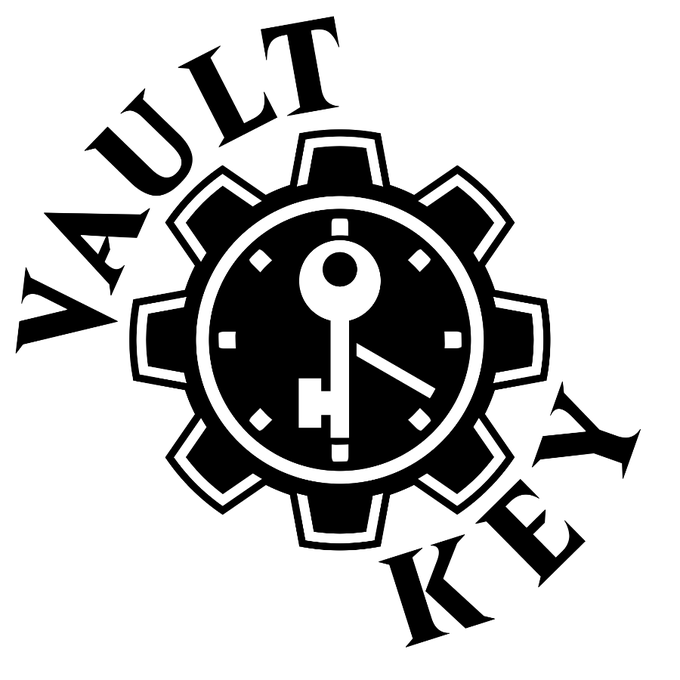
Do you know what this is? Magic: the Gathering fans, people who play in eternal formats, may recognise it. It’s a two-word reference to a combo of two cards that work together to let you take infinite turns, and therefore, most of the time, just automatically win the game in some way or another. It’s a powerful combo, and in the formats it’s in, it’s kinda a ‘good’ combo. It can be a total blowout – you can literally just start the game and in those formats, draw the right combination of cards that mean your opponent never ever gets a turn.
Anyway, this design is part of an idea I had where I thought about making a set of shirt or sticker logos that represent prominent two-card combos from Magic: The Gathering. What I did was ask the public if they had any ideas, and I got some… and they were pretty cool!
I hadn’t really framed the question clearly, though! I got a lot of cool combos people used in their decks, things they loved to do. There’s a neat combo with [mtg_card]Basalt Monolith[/mtg_card] and [mtg_card]Wake Thrasher[/mtg_card], for example!
I didn’t get advice or suggestions for what I wanted – but it’s okay. Instead, I got to listen to my friends, who were cool and neat.
Ripperology
You know what, I don’t say this kind of stuff very often, so here.
Ripperology is some of the worst kind of awful nerd garbage that exists.
Ripperology, or the ‘study’ of the murders of ‘Jack the Ripper,’ a dude who is about as historically verifiable as Jesus Christ, is the modern day pursuit of some kind of useful lasting information present in our modern day and available in any meaningful way about how in a city of three million people, one particular murderer was able to avoid capture from police. This is all done by breathlessly poring over various historical sources, which are of varying importance and impact, but also, crucially, reading a lot of people writing about those same sources, and building their own cases.
It also, when it crosses my path, seems to heavily relate to yelling at women on twitter, which I’m sure is just coincidence.
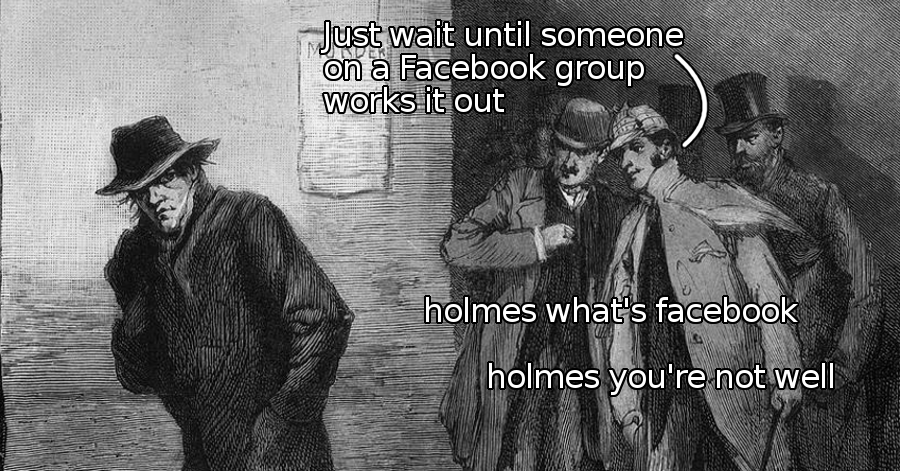
This isn’t me saying that ripperologists can’t have their fun, I mean, if they were dressing up as an elf or a Touhou I’d be defending them, but Ripperology exists in this weird space of somehow treating itself with a kind of seriousness and importance as if it’s a kind of forensic science. It’s the kind of people who will breathlessly butt heads about the possible meaning of journals whose authors admit they falsified them, delving deep into complex and elaborate webs of ‘scholarship’ about a subject with precious little actual information to it, but also in order to try and make it somehow hard to explain something that has a really simple explanation.
You don’t need some master of intrigue to get away with five crimes against marginalised people in a city of millions in a part of town already renowned for its criminal behaviour. You don’t need him to be an outcast prince or a secret surgeon or a dude with an exotic foreign-acquired brain disease or a vampire.
Do I have any special disdain for Ripperologists, too? Not really. I bet I know someone who has a pet theory about it, and as far as pet theories and conspiracies go, it’s pretty harmless to have one. It’s probably as goofy as Velikovsky believing that Jupiter farted out Venus at some point. It’s just this particular one, the idea of being captivated by this one.
It’s, like Pineapple on a Pizza, a game, essentially. People are playing their theories against one another, back-and-forth and joust and juke. It’s just, as someone who cares about games, a seemingly really awful one, a game is basically the most morbid and tedious kind of storytelling game, a sort of Dungeons and Dragons campaign where there’s no dungeon master nor rulebook but everyone is still going to be as obnoxious a rules lawyer as possible.
Edit: Hi there, Ripper forum hate-readers! Just so you know, you live down to my every expectations!
Digital Archaeology at Paragonwiki
I mentioned that I’ve been looking at the rehabilitated City of Heroes, and that it’s for work. This is ostensibly true. I’m obviously also playing a videogame I love to bits and finding people to pretend to be a superhero with. I have a spreadsheet set up, and boy, that’s the kind of thing that leads to silly behaviour.
How silly?

What I’ve done to start with is a big sheet that starts with a bunch of fields, then as I need to track things about characters that aren’t unique, I just add a column and put stuff in it. That means sometimes I get charts as a result like this, sensible chart that shows my current distribution of character origin. Think of it as a kind of character genre: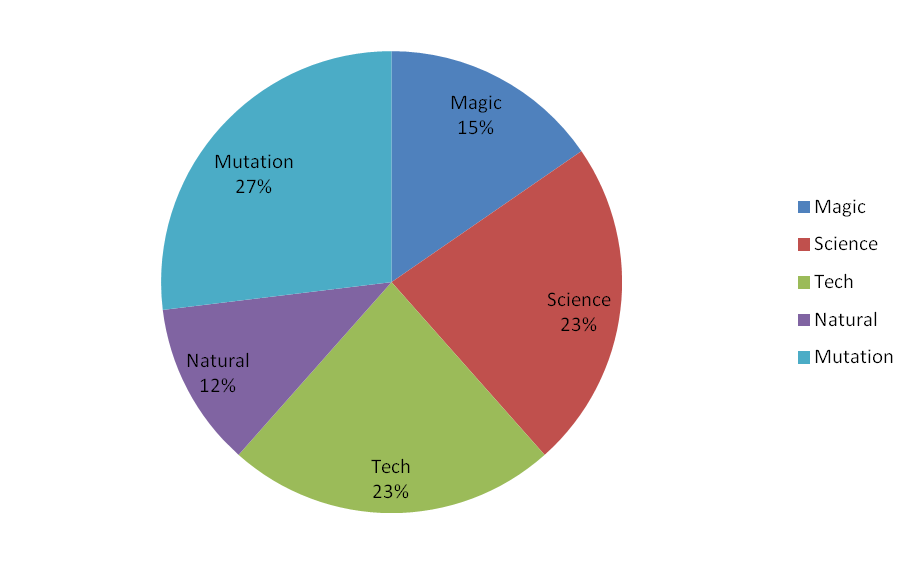
That’s sensible! That makes some sense.
Then there’s this:
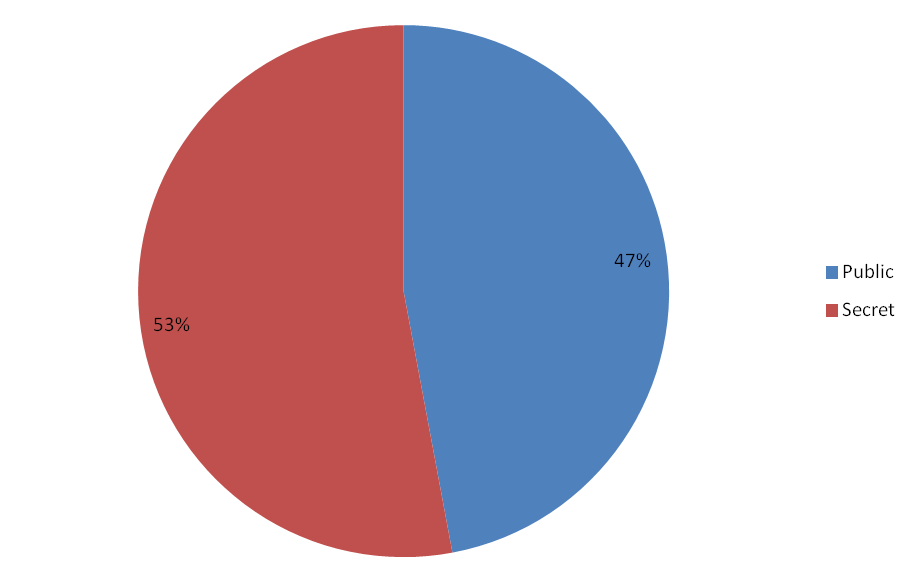
A chart mapping how many of my characters have secret identities versus how many have public identities. Or there’s this chart:
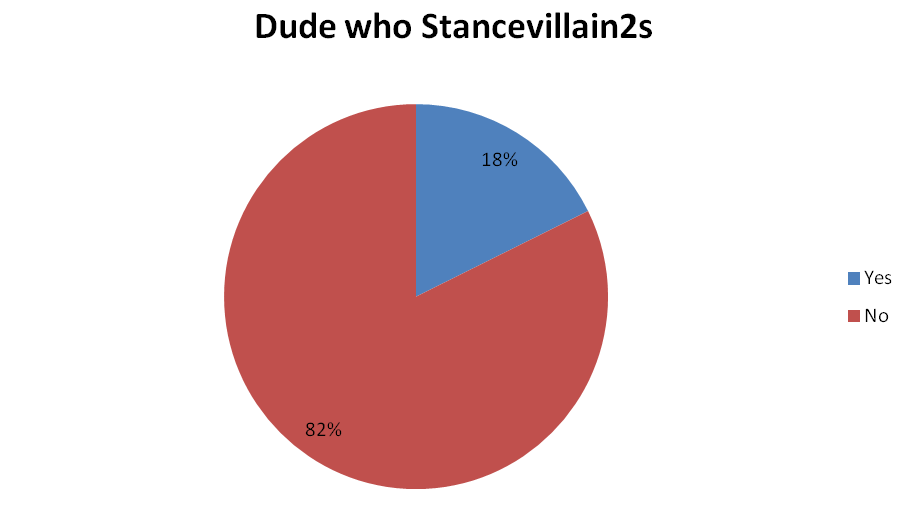 Which of my characters are men (dudes) who use the StanceVillain2 emote as a default standing position around people. That’s this emote, here, which I was able to obtain from the Paragon Wiki really conveniently, because that was archived.
Which of my characters are men (dudes) who use the StanceVillain2 emote as a default standing position around people. That’s this emote, here, which I was able to obtain from the Paragon Wiki really conveniently, because that was archived.
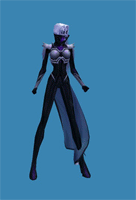
When I started working on this new version of the game, I made a choice to not just replicate my old characters. I wanted to make sure I made new characters, or ‘corrected’ the powerset choices of older characters. A character who was built and levelled as a Dominator once might become a Brute this time. A character who was a Brute became a Tanker. Still, I wanted to play with the old looks I had, and update them, and play some of my old characters again – oh hey, another chart –
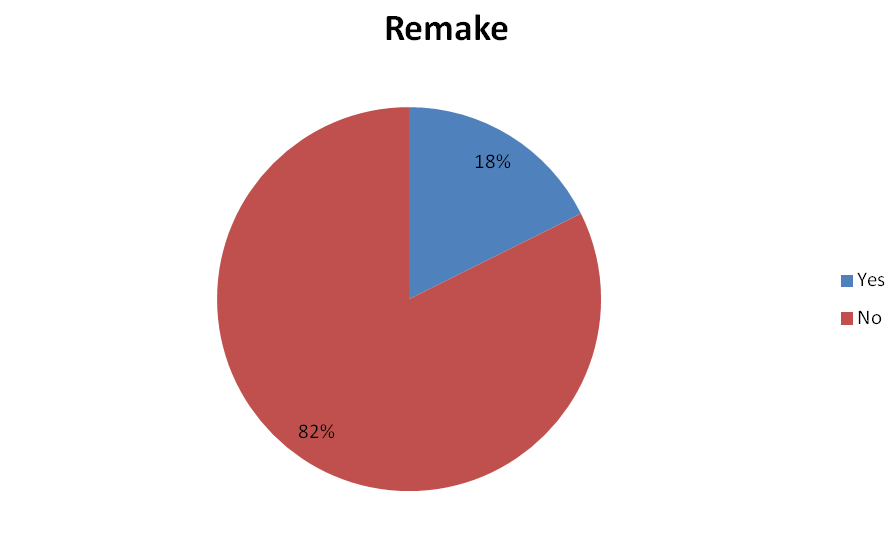
And then I realised just how what I was doing, and more than that, I realised the resources I had at hand. Because to check the emotes, I looked up Paragonwiki. To check out my old characters, I looked up a community wiki. To set up my characters ahead of time, I looked at old binds I’d had saved in a text file for five years.
Five years is not a long time, not really, in terms of data storage. There are people with computer data from twenty years ago, thirty, fifty years ago. When this game disappeared, there were all sorts of people making the conscious choice to spend money and time and storage to keep things saved, to keep things available, in the name of… what? Hope? I don’t imagine we were expecting the game to come back.
Keeping these things around was itself a form of cultural practice. A feeling of comfort, a sort of wistful joy that came from knowing what had been lost and wanting to make sure whatever of it we had was not gone. We grieved this game, and in many ways, we grieved it through memorialising it. Not with maudlin pledges, but with the careful sorting of documents and notes and historical preservation.
And now we don’t have to.
For a little while.
Story Pile: Dropped Stuff
I watch a bunch of stuff these days, thanks to Netflix, and as a media criticism junky, I find myself enjoying having a platform to write about almost everything I watch. There’s some reasons I don’t write about some things – for example, any media that tends towards including sexual assault, that tends to just get junked. Anytime a work is actively homophobic or where I’ve learned a central creator or person involved is particularly a known bad person, for example.
There’s a lot of reasons to do this! I kind of hate when I talk about something and people immediately want to change the subject to not what I talked about, or want to use a particular artist as an avenue to complain about something else. This has happened to me a few times, where what I will think of as very well intentioned people will interrupt me talking about thing A to instead try and make the conversation about thing B, believing it to be more important.
And sometimes I’ll consider a work too large to talk about, like Longmire, which is pretty bad, but it has some good stuff, but it does a bad job with it, and yeah okay, I kinda just summarised the whole series and we’re moving on. Sometimes, rarely, I’ll just ditch on a piece of media because it kind of bores me and there’s nothing in it I want to talk about. And sometimes I’ll ditch on a work for some other reason and I find myself yet wanting to say something.
And here’s a little round-up.
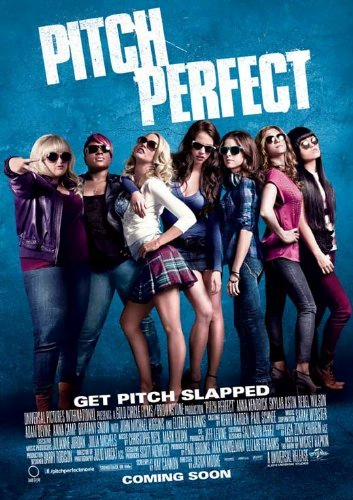
Pitch Perfect
I wanted to like this movie. I really thought that making a Sports Movie that was a Musical movie like Hercules that had some reason to do diegetic musical numbers could be really cool and it’s full of great actors. If nothing else, it has John Michael Higgins, Mathnet alumni and later Legend of Korra voice actor! I like the stuff that dude does!
Pitch Perfect then introduces Rebel Wilson, and what ensues is a set of jokes about how clueless she is about Jewish culture that I cringed myself inside out and closed the movie. Jokes about being from a backwoods in Tasmania who has no idea about how Jewish culture works just smashes my sense of disbelief because:
- There are Jewish people here, you know
- American media is full of Jewish people, and that’s what we watch on TV.
Anyway, realising that Rebel Wilson’s character would be hilariously quirky and not eventually punished for being an arsehole (because hey, can’t make the fat girl feel bad for being shitty), I didn’t feel any reason to go back and try more of this one. Basically she made such a great example of a first impression of a miserable arsehole I felt it best to not actually hang around and give her a second chance proving it.
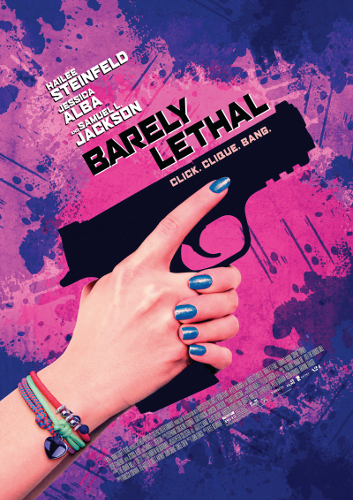
Barely Lethal
This movie has Jessica Alba and Sophie Turner and Samuel L Jackson and Rachael Harris and Steve-O, wait, really? What the hell? And the premise is pretty robust; teen assassins made by a government organisation to kill people, but one breaks away to have an ordinary life as high schooler, and she approaches becoming a normal girl as an assumed identity through research and performance.
I was pretty on board with this movie being generally pretty funny and kinda okay, and I was honestly almost considering throwing a suggestion to my friends as an example of a spy movie about girls and their feelings and maybe the whole strain about performing as a girl could give my friends some comforting trans girl feels.
And then in the peak of the movie, the villain randomly calls another girl a tr*nny.
Just.
Y’know.
There, just randomly.
The thing with comedies in this way is that it’s pretty much always going to be the jokes that sell you on whether or not you engage with a story. They need to show you that you’re following along, that you understand the relationships and the characters, and the kind of world they live in.
And in this one, the only mention of trans people is a really hurtful slur and it’s wielded as an offhanded punchline.
And well, that sucks.
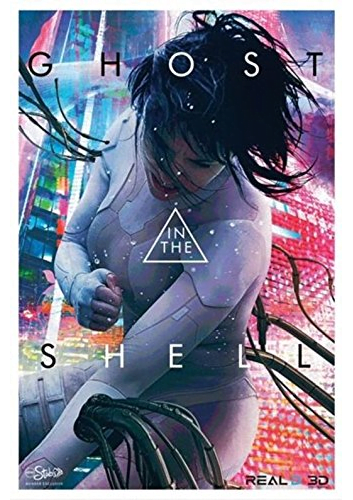
Ghost in the Shell
There’s a conversation around this movie, and it does directly connect to my work. There’s elements of representation, there’s questions of identity, there’s transmedia and transnational media, there’s cyberpunk and commercialisation and the real failure states of expensive movies and also the potential ramifications and moral relationship to these controversial works and the trajectory of Scarlett Johansson, as a bankable action star to generally a deeply embarrassing person.
That’d be great, that’s one of those things the Story Pile is great for. You dive in on a piece of media, then you use it as a tangent point to talk about those other things you want to.
And yet.
yet.
I can’t bring myself to watch this movie. It’s far too bloody dull.
The Coming Week’s Coming Tension
It’s postgraduate week at my uni.
That means this week, I have a really important thing due.
oh heck.
The long and short of it, for reference, is that I’m basically at some point in this week – depending on a schedule – presenting for the uni, proof that I haven’t spent this past year of PhD work just picking my nose. The document involved for this is – as I write this – in iteration four, and each iteration is about the length of a book, and each iteration has been refined individually many times and even completely restarted at least once.
It is a big task. I have to get up in front of people who can say whether or not I get to continue doing this! If I’ve been wasting everyone’s time! I am going to stand before a crowd and be judged.
Anyway so if I’m a bit twitchy this week, that’s why.
3.6 Roentgen
What the hell. This is a meme. Let’s talk about a meme.
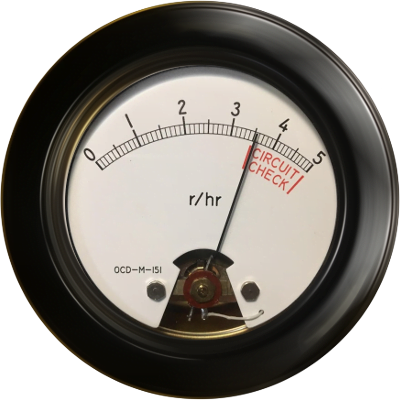
In HBO’s Chernobyl, a series about the single greatest anthropocentric disaster in recorded history (so far), there’s a sequence where a bunch of scientists standing in a reactor building to manage a nuclear reactor that’s just exploded do a scan to check the level of radiation. The reaction they get is 3.6 Roentgen per hour, which is, in the scheme of things with you and I, in our modern day, ridiculously high; a person gets about .6 Roentgen every year in our modern lives. So that’s six times a normal yearly dose in an hour. That’s really high.
In terms of a nuclear power plant, that number isn’t that high, but it’s definitely high. And when the accident happens, they share that number with central control and that number gets repeated and reiterated on. Then there’s tension about what that means, and there’s misinformation about it, and so on and so forth, but the point is that the reason we keep getting 3.6 Roentgen, the story reveals, is not because that’s an accurate reading, but because that’s the highest value these devices can check. The actual value is much higher, and it’s so much higher that they don’t ever find out how bad it is until they build a specialist device and then drive it in on a truck to scan it and it’s all dreadful.
Continue Reading →Game Pile: Wonder Girl!
Years ago now, I, on a whim, wrote an article talking about a little-known Master System exploration platformer (what you may call a metroidvania), called Wonder Boy III: The Dragon’s Trap. I wrote about it because it was a rare gem, it connected to my childhood and in all my time of watching a SNES-dominated game landscape, I never saw anyone bring it up, even in conversations about the entire genre of exploration platformer. It was a curiosity, and I tied it into a conversation about transformation and becoming, and how the different dragons, perhaps coincidentally, mapped to interesting themes of the world we live in and the way dragons represent power.
Then, about a week? A month? It feels like almost no time at all, but very much after I released that, a teaser dropped from Lizardcube showing that not only were they remaking this game, but they were doing so with a level of aesthetic devotion and purity that seemed too good to be true.
And then it came out, and it wasn’t too good to be true.
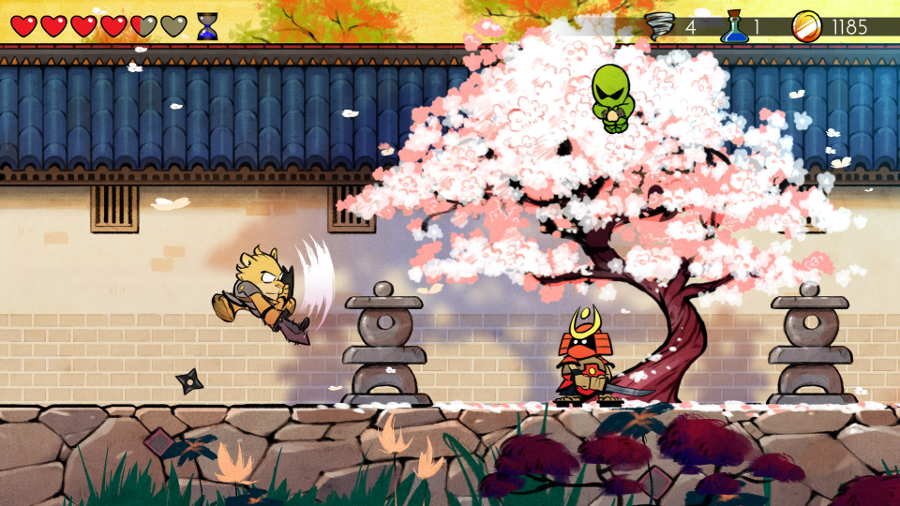
This was purely a coincidence, a completely unintentional and unexpected alignment between my random whims and the intentions of a group of other people who very clearly had not forgotten this delightful gem of a game. I wish it’d come from some place of insider knowledge, that I’d been able to guide this along or build hype, but it really was nothing but a coincidence.
It launched in 2017 and I haven’t goten around to talking about the remake.
First, I just waited; it didn’t launch on the PC at first, starting on the Switch. I was waiting to buy it on the PC, but it turns out Fox had gotten it on the Switch, in the hopes of luring me to play it (a thing I don’t really do much). Then as I got my life in order to get around ot playing games on the Switch, I finally got into playing it, and then something interrupted me. Then I went back. Then I hit a wall. Then I went back. It has been nearly two years of stop-and-start work getting to the finish of this game that was, once, a lofty ambition for me, a game I so wanted to say I had finished that its incompleteness haunted me for decades.
I still haven’t finished it.
Carthage
I have a strange love for losers.
I mean, I make fun of the Confederate flag waving assholes, and it’s worth remembering that that’s good, because they’re losers, and they should always be forced to confront that they’re losers, and they lost because they were bad at winning, and this is just a long aside to dunk on the Confederacy. But not all losers are that kind of loser. Sometimes you lose not because you were wrong, or because you were on the wrong side, or because you’re bad, but you lose because the bad people had more stuff. They had more money and more people and they didn’t even realise they were the bad people, because they were removed from the bad things they did.
I think about the people that lose against empires.
I think about Carthage.
I think about Carthage, and the story of Hannibal, a general who tried audacious things and succeeded. I think about bloody battles in the desert by mercenary armies. I think about the strangeness of a country whose big sin was not really doing enough for military infrastructure and how it was the victim of an empire next door that was. I think about how you can win a dozen fights in a row, but if your enemy can handle losing, and you can’t, then it doesn’t matter.
Carthage is on my mind because while history tells us that Carthage lost, there were a lot of times and places in Hannibal’s campaign that he won. There’s a lot of people who were living their lives and having what they thought of as important conversations about the future of Rome and their campaigns for political office and governorship or whatever, and then Hannibal happened to their territory, and they’re just gone.
Just forgotten.
This is what I’m thinking about, when I’m thinking about this card game I’m making. The different things nobles can do, these little festivals and parties and politics and territorial disputes and fights over who has the best land or best marketplaces, all while quietly aware that you can’t change the future.
That Hannibal is going to happen.
The idea for this game, the idea that I’m working with, is that of a stacked deck. At the start of the game, players get their cards, then the deck gets loaded; you shuffle up and deal out stacks of cards. Into each stack, you shuffle one of a number of cards, then you put those stacks on top of each other. Now you have a deck of events that everyone draws from, to play their cards and live their lives, and then one point, near the end…
Hannibal happens.

Fargo, Season 2, Episode 9
Hey, have you seen this episode of Fargo? No? Interested in it? Care about spoilers? Don’t care about spoilers? Well, okay, look, no matter how you cut it, this is a thing where it’s worth being deliberately ambiguous about what it is, and with that in mind, here’s a break and an image for the twitter preview so you can be pretty sure whether or not you want to read on.
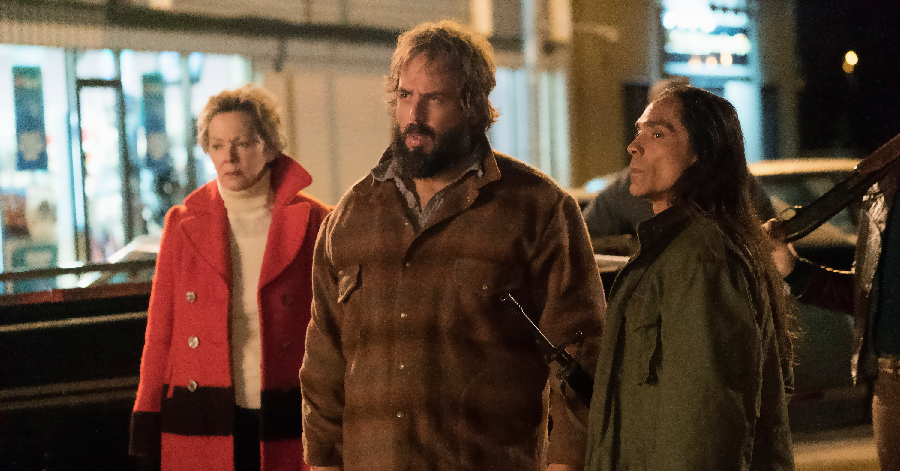
Jesus And The Widow’s Mite
Time to time Jesus comes up on the timeline and I watch as people who are generally well-meaning people try to harmonise together the Bible and the oppressive behaviour of Christian hegemony. There’s usually some sort of deference to a Gandhi quote, some sort of next-levelling smugness of well Jesus was great, Christians are bad. Maybe you’ll see something like Jesus was a leftist or Jesus was an ally or a truly amazing take Jesus was more of a trans person and on the one hand I try to file that under ‘fanfiction’ but then people use it to discuss real world political behaviour of a culture that has probably a third of the world’s resources and is using them to kill people.
It’s basically an attempt to make Christians feel ‘not so bad’ about being part of a great big dreadful machine, which is not something I see typically extended to things like heterosexuality or cisgenderness.
It annoys me, personally, because Jesus isn’t a cool guy who’s being mangled by his followers.
Jesus is a total dick and his teachings are full of confused morals and justifications for evil. The only reason people treat him like he’s good is because we treat his story as if he’s meant to be good and interpret his positions that way. There’s a constant decontextualisation of Jesus – that’s what Sermons are for! – that turn his positions into whatever we need them to be, and want to pointedly make sure you don’t relate what he said today to what he said yesterday, because if you do, you might go ‘hang on a second, fuck you Jesus.’
For example, the story of the Widow’s Mite. Now for the purpose of this consideration we’re going to treat Jesus like he existed and did the things that are kind of fundamentally necessary to the Christian narrative of Jesus. He didn’t, and he didn’t, but let’s just pretend for now. Treating this text as a text.
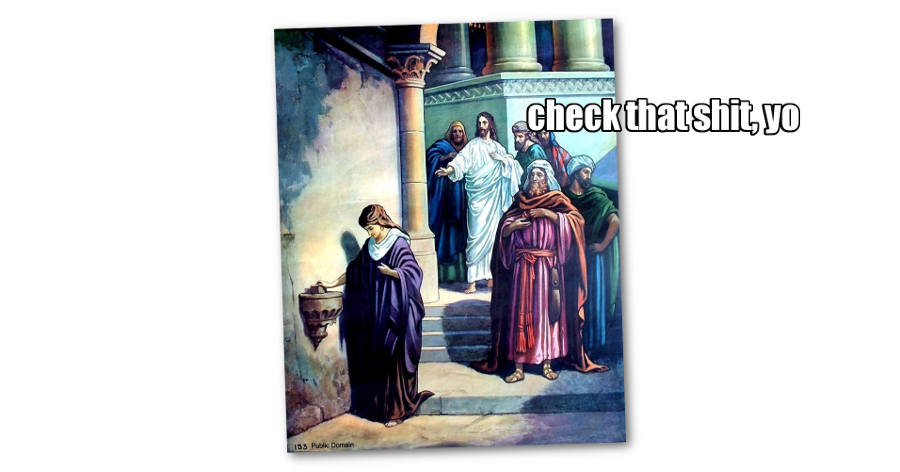
The story, which appears in Mark (the first draft) and Luke (the second last draft), tells of a time when Jesus and his disciples were rubbernecking in the temple and watching people do their weekly donations to the temple’s upkeep. Rich people came in and dumped large amounts of cash, and a poor widow came in and gave a ‘mite’ – one of the smallest currencies they could give. Jesus turns to his disciples and says:
3 And he said, Of a truth I say unto you, that this poor widow hath cast in more than they all:
4 For all these have of their abundance cast in unto the offerings of God: but she of her penury hath cast in all the living that she had.
Then we nod and tap our chins and we move on to the sandwiches and coffee after church.
Now think about this in the context of the fact that Jesus is meant to be the perfect human sacrifice that redeems us our sins. Remember that Jesus is God in this interpretation of the faith, that he talks to and experiences the voice of God, and that he is aware of God’s plan.
When Jesus submitted himself to torture and death, that was a bad weekend out of an infinite life and he knew he was going to survive this. We’re told it’s an important, meaningful sacrifice, it’s meant to be the ultimate sacrifice, but in this case, Jesus is the wealthy, giving a meaningless fraction of his wealth (time), and it wasn’t going to bother him a week later. It was performative, it was literally done so he could show off to people millenia later for whom he had done nothing.
If it costs you nothing, Jesus, what does it mean that you’re giving it up?
Story Pile: Titans
You know, one thing I’m really glad of, in this current era of missing the point in the most catawumpus ways, is that nobody’s gone out of their way to try and make a standalone Teen Titans live action TV series. It’s just such a bad idea to approach the Titans in a way that isn’t already ensconced in a larger media space.
I mean, think about it.
Things That Didn’t Work
Hey.
You know how I write something every day?
Some of those things aren’t good enough to share. Some of them aren’t funny or interesting or engaging. Some of them are just a bit short. I know I’ve had my word counts creeping up this year – I mean, a thousand words is pretty typical. It’s weird, because as I write more, I find myself feeling obligated to do more research, and while that’s great for sinew, it does mean it’s a little hard to write anything light.
Here’s some stuff I didn’t write, or if I did write it, you can’t prove it.
- A full write-up of the Halflings from 3.5 D&D which mostly just rearranged sentences as I tried to make them sound interesting and couldn’t
- A review of Mirror’s Edge from 2009
- A short story about a tower being climbed by some adventurers, with the big twist being that the staircase was a screw that drove the tower down into the eart, to literally no meaningful end
- A short story about mind controlling chip tunes with a ‘but jake was a zombie!’ twist at the end
- An entire outline for a 3.5 Race book meant to focus on orcs and gnolls
- A review for ‘ozechoc’ an out-of-production chocolate milk powder
- Writing from back when I had to schedule caching youtube videos overnight
- A step by step guide to breaking the stat cap in Quest For Glory 2
- An autopsy of a supergroup collapse from almost ten years ago that nobody cares about any more
- A discussion of just how weird a human Mitt Romney is and why it’s supremely weird that he’s taken seriously
- A long list of insulting things I’d called Tony Abbott in one pre-discord group chat
- Spreadsheets for organising superhero powersets
- New spreadsheets for ensuring an interesting gender spread across different character roles
- An analysis of the 4th Edition D&D characters I’d played in weekend games and their comparative threat value
- A bunch of posts that just talk about how great my dog is
Sometimes, you gotta clean out the cobwebs.